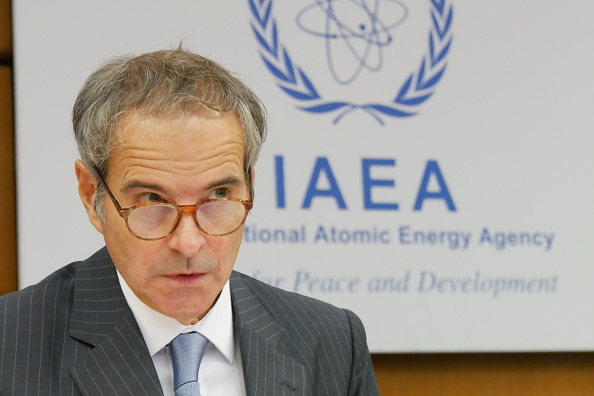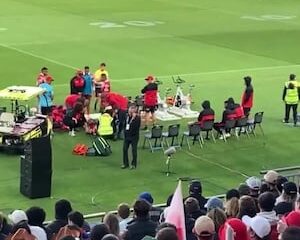Politics
Iran Accelerates Cleanup Efforts at Mojdeh Site Following Strikes

Iran is undertaking significant demolition activities at the Mojdeh site, aiming to eliminate evidence of potential nuclear weapons research. Satellite imagery analyzed by the Institute for Science and International Security indicates a rapid effort by Iran to dismantle damaged buildings, which may have been linked to nuclear weapons development. This institute, led by former UN nuclear inspector David Albright, focuses on preventing the proliferation of nuclear weapons.
The report’s timing coincides with ongoing discussions between the International Atomic Energy Agency (IAEA) and Iranian officials regarding the resumption of inspections. These inspections have been interrupted due to recent military actions, including a conflict between Israel and Iran. In response to Iran’s actions, Britain, France, and Germany are reportedly initiating processes to reimpose sanctions related to Iran’s violations of the 2015 nuclear deal.
Details of the Cleanup Efforts
According to the IAEA, Iran is legally obligated to allow inspections to resume. The agency aims to visit key facilities, including Fordow, Natanz, and Isfahan, to verify Iran’s existing stockpile of over 400 kg (882 pounds) of uranium enriched to near weapons-grade levels. Rafael Grossi, the head of the IAEA, emphasized the urgency of these inspections, stating that they should commence “as soon as possible.”
The Mojdeh site, also referred to as Lavisan II, is located adjacent to Malek Ashtar University. The facility has been under scrutiny following two Israeli airstrikes on June 18, 2023, which targeted multiple locations across Iran. The IAEA has established ties between Mojdeh and the AMAD Plan, a nuclear weapons development initiative that was reportedly discontinued in 2003.
Consequences of Recent Strikes
The first Israeli strike on the Mojdeh site impacted several structures, including one associated with the Institute of Applied Physics, and another linked to the Shahid Karimi Group, which has faced US sanctions for missile-related activities. Satellite images from Maxar Technologies revealed that subsequent strikes destroyed the Institute of Applied Physics and damaged nearby facilities, including a security building.
As cleanup efforts progressed, satellite imagery indicated that by August 19, the demolished buildings had been entirely cleared of debris. This rapid demolition is interpreted as a strategy to “sanitize” the site, potentially hindering any future inspections from uncovering evidence of nuclear weapons-related activities.
The developments at the Mojdeh site raise concerns about Iran’s compliance with international agreements regarding nuclear proliferation. Tehran has consistently maintained that its nuclear program is intended solely for peaceful purposes, a claim that remains contested by various international entities. The ongoing situation underscores the complexities of nuclear oversight and the geopolitical tensions surrounding Iran’s nuclear ambitions.
-

 World1 week ago
World1 week agoPrivate Funeral Held for Dean Field and His Three Children
-

 Top Stories2 weeks ago
Top Stories2 weeks agoFuneral Planned for Field Siblings After Tragic House Fire
-

 Sports3 months ago
Sports3 months agoNetball New Zealand Stands Down Dame Noeline Taurua for Series
-

 Entertainment3 months ago
Entertainment3 months agoTributes Pour In for Lachlan Rofe, Reality Star, Dead at 47
-

 Entertainment2 months ago
Entertainment2 months agoNew ‘Maverick’ Chaser Joins Beat the Chasers Season Finale
-

 Sports3 months ago
Sports3 months agoSilver Ferns Legend Laura Langman Criticizes Team’s Attitude
-

 Sports4 weeks ago
Sports4 weeks agoEli Katoa Rushed to Hospital After Sideline Incident During Match
-

 World2 weeks ago
World2 weeks agoInvestigation Underway in Tragic Sanson House Fire Involving Family
-

 Politics2 months ago
Politics2 months agoNetball NZ Calls for Respect Amid Dame Taurua’s Standoff
-

 Top Stories2 weeks ago
Top Stories2 weeks agoShock and Grief Follow Tragic Family Deaths in New Zealand
-

 Entertainment3 months ago
Entertainment3 months agoKhloe Kardashian Embraces Innovative Stem Cell Therapy in Mexico
-

 World4 months ago
World4 months agoPolice Arrest Multiple Individuals During Funeral for Zain Taikato-Fox





















